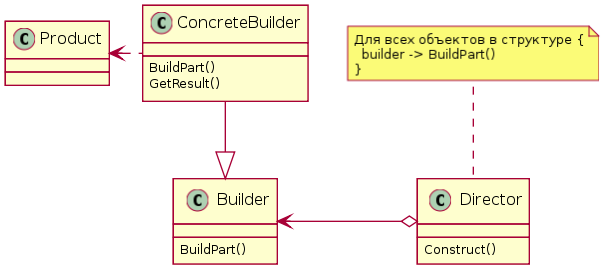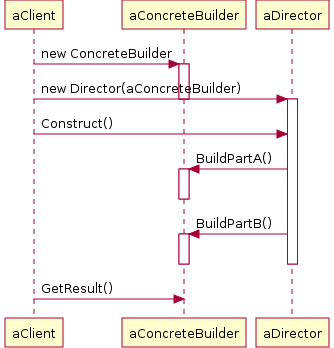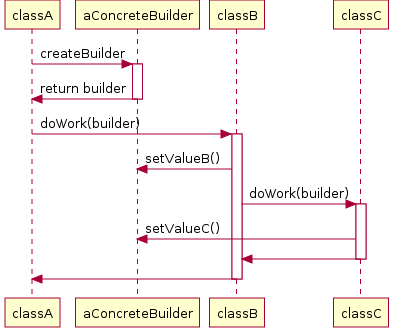Intro
Builder pattern seems to be one of the most versatile patterns of all
creational patterns. Its role is usually underestimated and it usually goes
unnoticed among other easier for understanding creational patterns: Abstract
Factory, Singleton, Prototype. Further I suggest to review some of
variations of Builder pattern. In certain cases the variations bring
the pattern closer to Visitor pattern. In other cases the modifications bring
it closer to Abstract Factory pattern. Nevertheless the way it is used stays the same.
All the variants give us fine tuned control over the dependencies and modularity
of the code where the Builder pattern is used.
Classic Description
Builder pattern is widely known from the book by Gang of Four[1]
Builder pattern separates the process of construction of a complex object from
its representation. So that the outcome of the same process of construction
can be different.
Classic applications of builder pattern is presented on the class diagram

Sequence diagram

illustrates the relationship of builder and director with the client. This
variant of Builder pattern can be used in a code that is responsible for
building charts of arbitrary format:
1 2 3 4 5 6 7 8 9 | |
In this case the main application will be a client. The collector of the data for the diagrams will be a director. The construction of concrete charts(pie chart, histograms, line chart) will be done by a concrete implementation of builder - a class implementing ChartBuilder. This usage allows us to abstract out the process of construction from the concrete implementation of the object being constructed.
Modifications of The Pattern
In common practice we can encounter modifications of Builder pattern that
allow us to manage dependencies inside the project in various ways. The
modifications fall into different categories based on the location of
GetResult method call and on the number of directors.
Location of GetResult Call
Variations of Builder pattern can be classified based on the location of
GetResult call. GetResult method can be called either from the director or
from the client.
Invocation From Client
If GetResult method is invoked from the client then this variant is for
abstracting out the director from the implementation of resulting object as
it’s represented in the classic case.
Invocation From Director
In this case the result is required by the director itself, but the director
doesn’t know the implementation. If the client doesn’t invoke set-methods of
the Builder then this implementation of Builder pattern can be replaced with
AbstractFactory. In the case when a part of the director should be configured
before passing it to the director AbstractFactory is not suitable because it
focuses on synchronous object construction. In this case Builder pattern is the
most suitable option.
1 2 3 4 5 6 7 8 9 10 11 12 13 | |
The Number of Directors
Variations of the pattern can also be defined by the number of directors.
No Directors
There may be no directors. In this case Builder pattern is used as a constructor
with named arguments. Client and director are the same entity.
One Director
If there is one director then it leads us to the classical variant of Builder
pattern for abstracting out the product construction from its concrete
implementation.
Several Directors
There may be more than one director. Everyone in the chain of directors sets
the parameters that it knows about and passes the builder to the next director.
This variant of Builder pattern reminds more of Visitor pattern. Pattern
Visitor is usually used for handling Composite pattern. In the case of
Builder pattern the visited objects can have arbitrary nature. Here is an illustration
of the case with several directors:

Features of The Pattern
Inversion of Dependencies
One of the main reasons to use Builder pattern - inversion of dependencies. The
builder is passed to a director during construction, what ensures isolation of the
director from the implementation details of concrete builder.
Named Arguments of Constructor
Another reason as it’s specified in [2] to use Builder pattern can be a lot
of arguments of the class being constructed. Let’s take a look at a piece of
sample code.
1
| |
From this code it’s clear that value1 becomes A in the new product, and
value2 becomes B. It allows us to change the order of arguments in the
invocation. Named arguments make the code more readable. The invocation of
method GetResult is done by the director itself, which is also a client.
Builder’s role here is similar to the role of AbstractFactory pattern, but
unlike AbstractFactory pattern, who’s task is to give access to construction
of construction of a group of connected objects, Builder is focused on
construction of instances of only one class.
Decomposition in Time
This pattern also allows us to configure builder as we receive data necessary
for configuring it. So the construction can lapse in time instead of happening
at once as it’s done in factories or constructors. Builder pattern tracks the
consistency of the object being constructed and if some of the arguments are
missing it can throw exceptions or execute any other action required to inform
about the incomplete state.
Loosening Coupling
This approach also allows us to loosen coupling between classes. Each class can
set only the arguments this class is aware of and pass the builder further in
the chain of construction. The classes only need to know about the structure of
the builder and don’t need to know about each other. They also only work with
the methods they need to know of and don’t need to care about the rest of the builder.
This usage of Builder pattern makes it very similar to Visitor pattern.
Then method GetResult can be invoked when the builder is returned back
to the client from the chain of invocations inside directors(in the beginning
of the chain) or by the final director(end of the chain).
Tolerance for Change of Data Format
If Builder pattern is used as in sections Loosening Coupling and Several
Directors then if we need to collect more data we can use new methods only
where they are required keeping the rest of the chain of directors intact.
Instead of getting data through get methods sometimes it’s more flexible to
pass Builder pattern.
Example
Let’s illustrate what we described above in the case for several directors. Method GetResult can be invoked by classA as well as by classC. In both cases classA and classC can’t know anything about each other’s dependencies, what reduces dependencies of each of them, but gives them access to the required object. In addition to that classC receiving partially configured, can change only the part he knows about and as a result receiving different objects depending on the requirements.
The latest approach is particularly convenient, when the client class requires different instances of a class depending on the data that client class has, but IOC container restricts access to constructors.
Conclusion
Builder pattern is a sufficiently powerful and flexible instrument for
dealing with dependencies inside a project and inversing the dependencies.
Regrettably, the usage of Builder pattern requires writing a lot of
boilerplate code. It complicates effective usage of this pattern in modern
programming languages.
As Rob Pike appropriately mentioned in his presentation at OSCON 2010: patterns - are usually solutions whose implementation is missing from the language. We can only hope that working with builder pattern in future languages will be as simple as just writing a constructor.
Appendix A

Appendix B

Appendix C

Bibliography
- Erich Gamma and others. Design Patterns: Elements of Reusable Object-Oriented Software, 395 p.
- Bloch J. Effective Java. Second edition. Prentice Hall, 2008.
- More on getters and setters - JavaWorld [Electronic resource]. URL: http://www.javaworld.com/javaworld/jw-01-2004/jw-0102-toolbox.html (date of access: 06.02.2011).